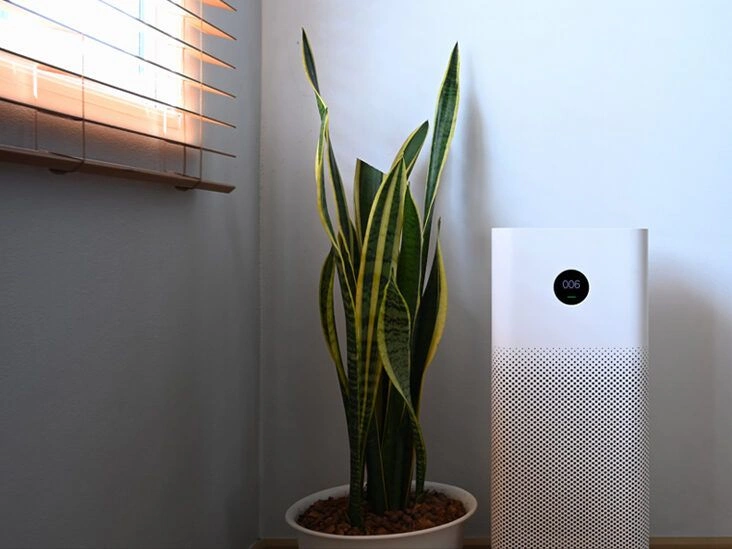An air ionizer emits negative ions into indoor air. These ions encourage tiny particles to bind together and settle onto surfaces, where they can be removed through cleaning. Reported advantages include reducing mold, bacteria, and certain viruses, among other potential benefits.
Many people worry about outdoor air pollution, but indoor air quality — in places such as your home or workplace — also matters.
Airborne contaminants like dust, chemical pollutants, and microbes can degrade indoor air quality. That can make breathing more difficult and, over time, contribute to adverse health outcomes. Existing respiratory conditions, such as asthma, may also worsen.
If you’re looking to improve indoor air, you may be wondering whether ionizers are effective. Ionizers operate by releasing negative ions that attach to airborne particles. The goal of an air ionizer is to encourage particles to settle out of the breathable air.
Ionizers can help reduce certain airborne contaminants, but they come with potential drawbacks. This article explains how ionizers function and outlines their benefits and risks.
How does an air ionizer work?
To understand ionizers, it helps to know what air ions are.
Air ions are molecules that carry an electrical charge. They’re invisible and present throughout the atmosphere. Negative ions have gained an electron, while positive ions have lost one.
An air ionizer releases negative ions into a room. These negatively charged ions attach to small particles, such as those found in cigarette smoke.
Charging the particles gives them an electrical attraction to one another, which makes them clump and fall onto surfaces like:
- walls
- ceilings
- floors
- tables
- curtains
- rugs and carpets
- metal collecting plates inside the device
After these particles settle, they can be removed by routine cleaning.
Can ionizers kill viruses?
Research has shown that negative ions can inhibit viral replication in some contexts. Other studies have indicated that ozone — a byproduct of some ionizers — can inactivate viruses both in the air and on surfaces.
Ozone is a colorless gas created when ions transfer charge to airborne molecules. It can inactivate viruses by damaging their genetic material and outer membranes.
The COVID-19 pandemic prompted many businesses and public venues to install ionizers to try to improve indoor air and lower airborne SARS-CoV-2 levels.
Reviews from 2020 and earlier suggest that ozone can be effective against SARS viruses in general, but it’s not yet definitive how effective ionizers are specifically against SARS-CoV-2. Additional research is needed to determine whether ozone produced by these devices reliably neutralizes that virus.
Potential benefits of ionizers
Ionizers use negative ions to remove fine airborne particles, which can reduce odors and give a fresher feel to indoor air.
A review of ionization studies reported that negative ions have been associated with outcomes such as:
- inhibition of some viruses, bacteria, and molds
- reduced stress
- improved sleep patterns
- enhanced immune responses
- mood support

Drawbacks of ionizer use
Despite their potential upsides, ionizers have limitations and risks you should consider before buying one.
Below are some key disadvantages:
Not effective for asthma and allergy triggers
Ionizers are not effective at removing larger particles from the air — the kinds that often trigger asthma and allergy symptoms.
These larger particles include:
- dust
- pet dander
- pollen
For people with asthma or allergies, an ionizer alone may not provide meaningful relief.
Poor performance on odors and gases
Ionizers do not neutralize odors or gases, including volatile organic compounds (VOCs). VOCs are emitted from items such as paints, cleaning agents, and adhesives.
Because VOCs are indoor pollutants tied to health concerns, the inability of ionizers to reduce these gases is a notable limitation.
Ozone production
As noted earlier, ionizers can generate ozone when negative ions charge other airborne particles.
While ozone can have antimicrobial activity, it is also an irritant to the lungs. Short-term exposure to low levels of ozone can cause symptoms such as:
- throat irritation
- chest discomfort
- coughing
- shortness of breath
- difficulty breathing
Longer-term or repeated exposure may lead to issues like:
- reduced lung function
- worsening of asthma symptoms
- increased susceptibility to respiratory infections
- inflammation of lung tissue
Types of ionizer technologies
There are several styles of ionizing technologies available, including:
Bipolar ionization
Bipolar ionization produces both positive and negative ions. It’s frequently integrated with HVAC systems and other ventilation equipment. Because it’s relatively new, the body of research on bipolar ionization is still limited.
Ionizing fans
Fans circulate air using spinning blades, which helps increase ventilation. Some fans include an ionizing function, combining air movement with emission of negative ions.
Air purifiers that include an ionizer
An air purifier is designed to remove contaminants from indoor air and is also known by names such as:
- room air cleaner
- portable air cleaner
- air sanitizer
Typical air purifiers rely on filters and fans to capture dust and pollen, making them effective for people with allergies or asthma. Some models add an ionizing feature, offering particle removal via filtration while also releasing negative ions.
Bottom line
Ionizers emit negative ions that electrically charge airborne particles, prompting them to settle on surfaces like floors and ceilings. They may reduce some microorganisms, including certain viruses and mold spores.
People use ionizers to decrease fine particles and refresh indoor air, but these devices are not effective at removing larger particles associated with asthma and allergies. In addition, some ionizers produce ozone, a gas that can irritate the respiratory system.
If you’re considering an ionizer, research the specific model and consult your healthcare provider if you’re seeking improved indoor air for medical reasons. Always follow the manufacturer’s instructions when operating an ionizer or similar device.


















Leave a Reply
You must be logged in to post a comment.